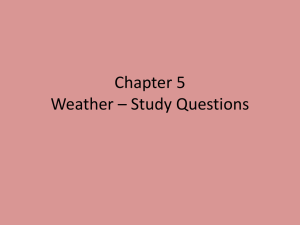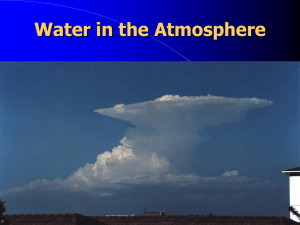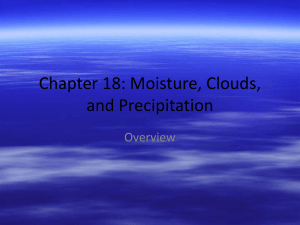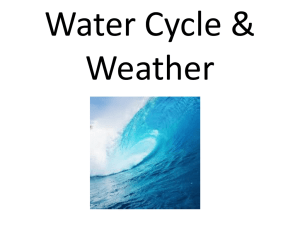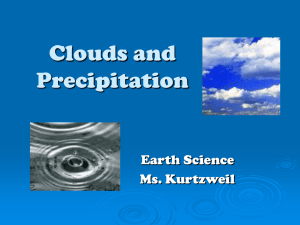Weather - WordPress.com
advertisement
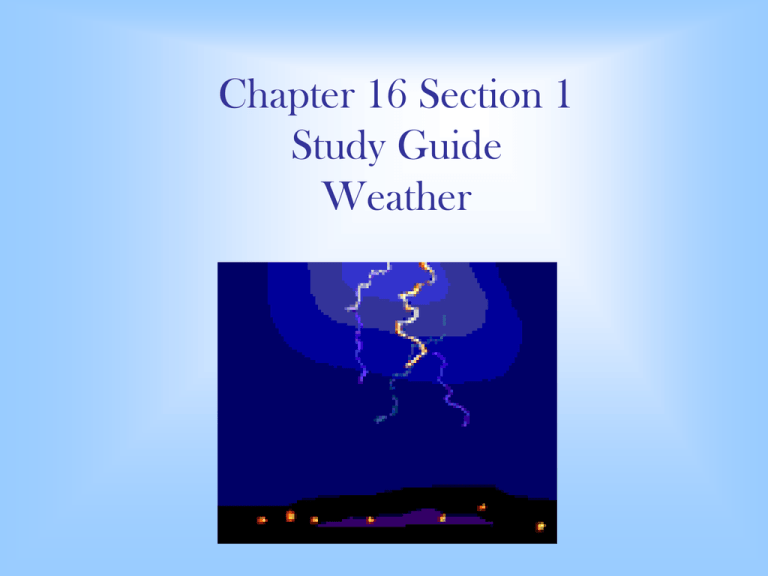
Chapter 16 Section 1 Study Guide Weather What is Weather? Weather: Weather refers to the state of the atmosphere at a specific time and place. Weather describes conditions such as air pressure, wind, temperature, and the amount of moisture in the air. Weather is the result of heat transfer and Earth’s air and water. Air Temperature: Air is made up of molecules that are always moving, even if there is no wind. Temperature is the measure of the average amount of motion of molecules. When the temperature is high, molecules in the air move rapidly and it feels warm. When the temperature is low, molecules in the air move less rapidly and it feels cold. Wind: Air moving in a specific direction is called wind. Wind moves from regions of high pressure to regions of low pressure. Wind direction can be measured using a wind vane or a wind sock, which point in the direction towards where the wind is blowing. Wind speed can be measured using an anemometer, which has rotating cups that spin faster when the wind is strong. Humidity: The amount of water vapor present in the air is called humidity. More water vapor can be present when the air is warm than when it is cool. When air is warm, the water vapor molecules in the air move quickly and don’t come together easily. When the air is cool, water vapor molecules move slower, stick together, and form liquid water droplets through condensation. When enough water vapor is present in the air for condensation to take place, the air is saturated Relative Humidity: Relative humidity is the measure of the amount of water vapor present in the air compared to the amount needed for saturation at a specific temperature. Air at 25O C is saturated when it contains 22g of water vapor per cubic meter of air, so the relative humidity is 100%. If air at 25O C contains only 11g of water vapor, the relative humidity is 50%. Dew Point: When the temperature drops, less water vapor can be present in the air. The water vapor will condense or form ice crystals. The temperature at which the air is saturated and condensation forms is the dew point. The dew point changes with the amount of water vapor in the air. When air near the ground cools to its dew point, water vapor condenses and forms dew. Forming Clouds: Clouds form as warm air is forced upwards, expands, and cools. When the relative humidity reaches a 100% in the atmosphere, the water vapor begins to condense in tiny droplets around small particles such as dust and salt. These particles are called condensation nuclei. The droplets of water are so small that they stay suspended in the air, and billions of the droplets form a cloud. Classifying Clouds: Clouds are classified mainly by shape and height, which vary with temperature, pressure, and the amount of water vapor in the atmosphere. The three main cloud types by shape are stratus, cumulus, and cirrus. 1. Stratus clouds form layers or smooth, even sheets in the sky. They form at low altitudes, and are associated with fair weather, rain and snow. o Fog is a type of stratus cloud formed when air near the ground reaches its dew point. 2. Cumulus Clouds are puffy, white clouds with flat bases. They can grow to great hights and can be associated with fair weather or thunderstorms. 3. Cirrus Clouds are fibrous or curly. They are high, thin, white, feathery clouds made from ice crystals. They are associated with fair weather, but can indicate approaching storms. Prefixes of cloud names describe the height of the cloud base. o Cirro = high clouds o Alto = middle elevation clouds o Strato = low elevation clouds o Example: Cirrostratus clouds are high clouds. They signal fair weather or an approaching storm. Altostratus clouds form at middle levels. Clouds associated with rain or snow have the word nimbus attached to them. (Latin for dark rain cloud) o When a cumulus cloud grows into a thunderstorm, it is called a cumulonimbus. o Nimbostratus clouds bring long, steady rain or snow. Precipitation: Water falling from clouds is called precipitation. When cloud droplets combine and grow large enough to fall to the Earth, precipitation occurs. The size of a raindrop depends on: o the strength of the updraft in clouds- strong updrafts can keep drops suspended where they can combine and grow very large. o the rate of evaporation as a drop falls to earth – if the air is dry, the rain drops can shrink or completely evaporate before they hit the ground. The four main types of precipitation are determined by air temperature. 1. Rain: falls in temperatures above freezing. 2. Snow: forms when the air temperature is so cold that water vapor changes directly to a solid. 3. Sleet: forms when raindrops pass through a layer of freezing air near the Earth’s surface, forming ice pellets. 4. Hail: lumps of ice that form in cumulonimbus clouds when water freezes in layers around a small nucleus of ice. Hailstones grow larger as they are tossed up and down by rising and falling air. HAILSTONES All images and text © copyright Gene Moore unless otherwise indicated. Batter Up! Hail Damage Hail about an inch larger than these stones broke this windshield. Chasers have witnessed golf ball sized stones about this diameter not break glass. It depends on the hardness of the stones and the angle of the impact. Occasionally a motorist can get lucky and get hit with a large soft stone when temperatures aloft are warmer. The soft stones crack apart absorbing the impact. In this case the stones were rock hard. Note the irregular shape of some of the stones. One on the left is elongated with small spikes, and others that fell that day were jagged. Near this location a particularly large stone was dug out of the mud; it measured five inches in diameter; although, that is a big chunk of ice the largest stone fell at Coffeyville, Kansas in 1970 and measured just under seven inches in diameter. I was there, and had an old Polaroid camera, but was so busy watching the storm I forgot about taking pictures. Hailstorms, Do They Look Different? Typical Hailstorm...Or Is It? A severe thunderstorm rolling across the western prairie. This storm blasted windows out of a town in western Oklahoma with golf ball size hail and 70 m.p.h. winds. The worst of the hail was under the dark shelf of clouds close to the ground. An early spring hailstorm turns the green grass white over the fields of west Texas. Note the lack of dark low clouds. We can see completely under this storm which contains almost all hail and little rain. Such pure hailstorms are more transparent then classic thunderstorms. Travelers may be fooled by storms with this appearance. Without the hail in the foreground this cloud would not be that threatening. Storm across the high plains may have deceptively high cloud bases. This feature allows more light to filter in under the storm clouds. Since hail does not occur in the density of heavy rain, this too lets in light making for a bright storm. This particular cell was dumping very large hail across northern Kansas in the yellow of the late evening sunlight. Long streamers and striations are visible in the clouds as evidence of the hail falling through them, but nothing is seen below cloud base. Storms do give away their secrets to careful observers. Note the thick streamers in the clouds. This a signature for very large hail when nothing is seen below cloud base. These streamers may be distinguished from typical virga streamers, which have a thinner appearance and carry the cloud base lower with them. This storm battered the area west of Abiline, Texas with softball size (4 inch plus) hailstones. It's quite likely this hail was coming from the anvil well above these clouds, and falling through the lower layers making the streamers evident.

